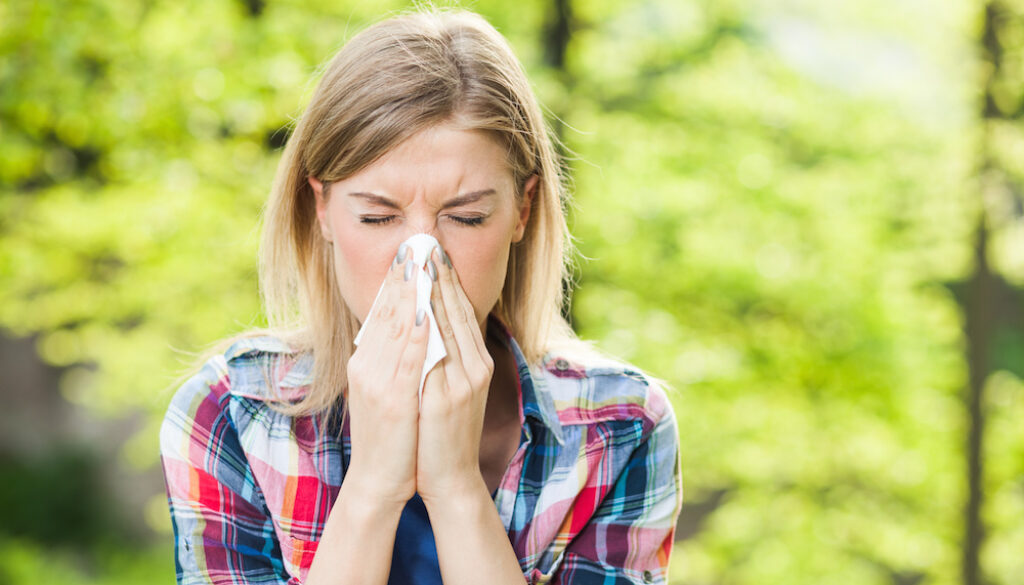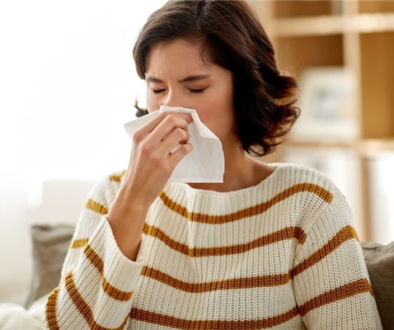A Step-by-Step Guide to Allergy Treatment
Recently, Raleigh, NC was listed as one of the top 100 most challenging places to live if you have allergies. The list is part of an annual report compiled by the Allergy and Asthma Foundation of America. The ranking takes into account factors such as pollen count and medication utilization.
Raleigh ranked #88, while Durham clocked in at #57. (In case you’re curious, Jackson, Mississippi earned the dubious #1 “honor.”)
Of course, this top 100 ranking will come as no surprise to Triangle residents who suffer through allergy season with sore throats and runny noses. If this sounds all too familiar, you’re not alone. More than 50 million Americans have some type of nasal allergy. In the U.S., allergies are the sixth leading cause of chronic illness, representing more than $18 billion in health care costs. Sometimes allergies can be treated with simple over-the-counter medicine, but this doesn’t always work. In addition, allergies can pave the way for other conditions such as chronic rhinosinusitis or allergic rhinitis. If you are one of the millions of Raleigh residents suffering from allergies, we’ve created this useful step-by-step treatment guide.
What causes allergies?

Allergies are caused by allergens. An allergen is anything that creates an allergic reaction. Those who live in North Carolina are all too familiar with allergy problems. Pollen, trees, grasses, weeds, pet dander—all of these can cause an allergic reaction. In addition, there’s also a genetic component involved—if you have allergies, then your children are much more likely to develop them as well. There are thousands of allergens, but the most common are:
- Pollen
- Pet dander
- Dust mites
- Mold
What happens during an allergic reaction?
Think of your immune system as the security guard of your body. When an allergen enters your body, your “security guards” go into full attack mode to stop the allergen invader. Your system remembers this allergen. When the allergen returns, it immediately goes into “red alert” mode.
Your body produces histamine, which is responsible for common allergy symptoms such as:
- Sneezing
- Itchy or watery eyes
- Runny nose
- Sore throat
- Hive
- Stuffy nose
You may have heard this cluster of symptoms called “hay fever.” Following are useful steps to help you as you seek treatment for chronic allergies.
Step One: Take a good look at your environment.
Did you know that hundreds of allergens could be nesting in your home, waiting for an opportunity to strike? While people blame the great outdoors or high pollen counts for their problems, often, the allergens inside the house can be equally troublesome.
Think about it: Every time you go outside to get the mail, you return with small, miniscule pieces of pollen on your shoes, which is then spread to your living room. When you take the dog for a walk, pollen gets lodged in his fur. When Fido jumps on the bed, the pollen jumps on it with him.
Also, if you haven’t washed your sheets in over a week, you may be inadvertently putting out the welcome mat for dust mites.
Even something as simple as removing dust-attracting magazine piles from your coffee table can reduce your chances of coming into contact with these allergens.
While no home can be completely allergy-proof, you can dramatically improve your situation by:
- Using dust-mite proof covers on your bed
- Purchasing washable curtains
- Closing windows during allergy season
- Taking off your shoes before walking through the house
- Purchasing furniture that is easy to clean
- Bathing your pet regularly
- Cleaning and treating plush toys
Your child probably has a favorite stuffed animal or plush toy, and you should be aware that these can harbor dust mites and exacerbate allergy symptoms in kids. Thankfully, they can be easily treated by putting them in the freezer for 24 hours. This will kill the dust mites. To keep the dust mite population under control, we suggest doing this on a monthly basis.
Mold is another source of indoor allergies, Following are some helpful tips to help you avoid indoor mold exposure:
- Limit the number of indoor plants in your home.
- Repair leaky pipes.
- If you find excess areas of moisture, be sure to address the problem as soon as possible.
Step Two: Schedule an appointment with an ear, nose and throat doctor near you.
Although over-the-counter allergy remedies are easily available, you should still see an ENT. Why?
Sinus problems aren’t always caused by allergies. Chronic sinus issues can be caused by infections or a structural problem. Perhaps you have a deviated septum or a nasal polyp. If so, these conditions can contribute to your misery.
Only an ENT can determine the primary cause of your allergies. At Raleigh Capitol Ear, Nose and Throat, we’ve provided allergy treatment for Triangle patients for more than 50 years. We’ve even established a Sinus & Allergy Center to provide the highest level of service and convenience to our patients.
Step Three: Determine what allergen is causing your problem.
You may think you are allergic to one thing only to learn it is something else. Your ENT may order intradermal titration skin testing to conclusively determine the cause of your misery. During this procedure, your skin is exposed to the most common allergens and then monitored to see if an allergic reaction occurs.
Step Four: See if you are a good candidate for immunotherapy.
No one wants to be on allergy medicine 365 days of the year. Yet for those who have year-round allergies, this may seem like the only choice. Fortunately, immunotherapy offers a viable alternative.
During immunotherapy—sometimes called “allergy shots”— your body is exposed to a tiny amount of the allergen that is causing your problems. Over time, your doctor gradually increases the dosage in order to “train” your immune system to build up a tolerance.
Step Five: Discuss immunotherapy options.
If you don’t like needles, you may be a candidate for sublingual immunotherapy (SLIT). SLIT utilizes the same process as regular immunotherapy, only the diluted allergens are delivered via drops that are held under the tongue for two minutes before swallowing.
SLIT has several advantages. It’s a great option for children and for those who travel a lot. Even better, it can be done at home. Our ENT doctors will be glad to discuss SLIT with you and help you determine if it’s the best treatment option.
Step Six: Follow the prescribed steps.
This seems obvious, but allergy treatment won’t work if you aren’t committed to it. Typically, patients start to feel the benefits of treatment after six months, though this will vary from person to person.
While immunotherapy is a very effective, it requires several visits to receive complete benefits. We always try to make this process as convenient as possible for our patients, but be aware that immunotherapy is a long-term solution, and therefore, don’t expect overnight results.
Step Seven: Follow up with your doctor.
It’s important that your ear, nose and throat physician monitors your progress. He or she will also know your medical history, which will be vital if you have any future infections or conditions.
You don’t have to suffer from seasonal allergies
Spring and fall are some of the most gorgeous seasons in the Triangle. Don’t let allergies hamper your enjoyment of your favorite outdoor activities. Speak with one of our ear, nose and throat doctors who will be happy to help you.
Interested in learning more? Take a look at some of our useful articles:
Is Your Home Hiding These Common Allergens?
Four Effective Treatments for Children’s Allergies
Top 10 Questions to Ask Your ENT Before Allergy Season
Is Immunotherapy Right for You? Answer These Questions to Find Out
Raleigh Capitol Ear, Nose, and Throat is the area’s premiere physician-owned ENT practice with six convenient locations throughout Wake County. Our board-certified physicians have extensive experience in treating both common and complex cases to help adults and children alike. We offer six local ENT offices throughout Raleigh, Cary, Garner and Wake Forest. For more information or to schedule an appointment, contact us.
Sources:
Asthma and Allergy Foundation of America. “The Most Challenging Places to Live with Fall Allergies.”
Mayo Clinic. “Allergy-Proofing Your Home.” Online
“Allergy Shots.” Online.
Ogg, Barbara. “Managing Dust Mites.” University of Nebraska – Lincoln. Online.




